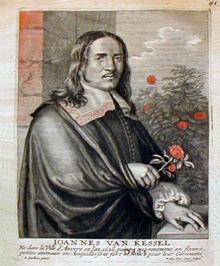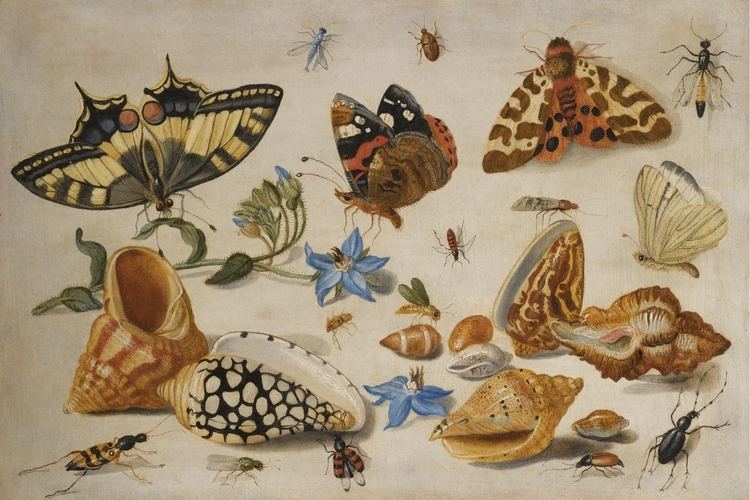Name Jan Kessel | Series The Four Continents | |
 | ||
Artwork The Continent of Africa, The Continent of Asia Children Jan van Kessel the Younger | ||
Jan van kessel the elder at brafa 2014 costermans of brussels
Jan van Kessel the Elder or Jan van Kessel (I) (baptized 5 April 1626, Antwerp – 17 April 1679, Antwerp) was a Flemish painter active in Antwerp in the mid 17the century. A versatile artist he practised in many genres including studies of insects, floral still lifes, marines, river landscapes, paradise landscapes, allegorical compositions, scenes with animals and genre scenes. A scion of the Brueghel family many of his subjects took inspiration of the work of his grandfather Jan Brueghel the Elder as well as from the earlier generation of Flemish painters such as Daniel Seghers, Joris Hoefnagel and Frans Snyders.
Contents
- Jan van kessel the elder at brafa 2014 costermans of brussels
- Jan van Kessel A collection of 134 paintings HD
- Life
- General
- Nature studies
- Garland paintings
- References

Jan van Kessel: A collection of 134 paintings (HD)
Life

Jan van Kessel the Elder was born in Antwerp as the son of Hieronymus van Kessel the Younger and Paschasia Brueghel (the daughter of Jan Brueghel the Elder). He was thus Jan Brueghel the Elder's grandson, Pieter Bruegel the Elder's great-grandson and the nephew of Jan Brueghel the Younger). His direct ancestors in the van Kessel family line were his grandfather Hieronymus van Kessel the Elder and his father Hieronymus van Kessel the Younger, who were both painters. Very little is known about the work of these van Kessel ancestors.

At the age of only 9, Jan van Kessel was sent to study with the history painter Simon de Vos. He further trained with family members who were artists. He was a pupil of his father and his uncle Jan Brueghel the Younger.

In 1644 he became a member of the Antwerp Guild of Saint Luke where he was recorded as a "blomschilder" (flower painter). He married Maria van Apshoven on 11 June 1646. The couple had 13 children of whom two, Jan and Ferdinand, were trained by him and became successful painters. He was captain of a local schutterij (civil guard) in Antwerp.
Jan van Kessel was financially successful as his works commanded high prices. He bought in 1656 a house called the Witte en Roode Roos (White and Red Rose) in central Antwerp. By the time his wife died in 1678 his fortune seems to have turned for the worse. In 1679 he had to mortgage his house. He had become too ill to paint and died on 17 April 1679 in Antwerp.
He trained other painters and also his own family members. His pupils included his sons Jan and Ferdinand.
General
Jan van Kessel the Elder's dated works range from 1648 to 1676. Attribution of work to Jan van Kessel the Elder has been difficult due to confusion with other artists with a similar name all active around the same time. In addition to his son Jan, there was another Antwerp painter with the name Jan van Kessel (referred to as 'the other' Jan van Kessel) who painted still lifes, while in Amsterdam there was a Jan van Kessel known as a landscape painter. To complicate things further, while he is usually referred to as Jan van Kessel I since he had an uncle also called Jan van Kessel he is sometimes referred to as Jan van Kessel II and his son Jan van Kessel the Younger as Jan van Kessel III. Another problem for attributions has been the fact that Jan van Kessel the Elder used two different styles of signature on his work. He used a cursive, more decorative signature for larger formats, which would have been difficult to read in a smaller painting. This practice lead to the erroneous assumption that these works were made by two different painters.
Jan van Kessel specialized in small-scale pictures of subjects gleaned from the natural world such as floral still lifes and allegorical series showing animal kingdoms, the four elements, the senses, or the parts of the world. Obsessed with picturesque detail, van Kessel worked from nature and used illustrated scientific texts as sources for filling his pictures with objects represented with almost scientific accuracy.
Nature studies
Jan van Kessel produced a great number of studies of animals such as insects, caterpillars and reptiles as well as images of flowers and rare objects from all over the known world. He showed himself to be a keen observer and his animal studies were praised in his day for their meticulousness and precision. His work in this field reflects the contemporary worldview in which the appreciation of art and nature went hand in hand. That same desire to collect and categorize the natural world, which had given impetus to the creation of the Kunstkammern and Wunderkammern in the late 16th and 17th century, inspired the artists of the day to achieve the same in painted form. Jan van Kessel's grandfather Jan Brueghel the Elder had already demonstrated in his work how artists, starting from empirical observation, could represent the world through ordering and classifying its many elements.
An important influence on his animal studies was the scientific naturalism of the Flemish artist Joris Hoefnagel known primarily for his illuminated manuscripts and still lifes on vellum. Hoefnagel's studies of flowers and insects were engraved and published under the title Archetypa studiaque patris Georgii Hoefnagelii by his son Jacob Hoefnagel in 1592 in Frankfurt. The book is a collection of 48 engravings of plants, insects and small animals shown ad vivum made after studies by Joris Hoefnagel and was very influential on next generations of animal painters.
Van Kessel's animal studies distinguish themselves from the dispassionate approach of his predecessors, who arranged the various flora and fauna in rows, as if they were specimens in a collector’s cabinet. Van Kessel put greater emphasis on composition and aesthetic without abandoning an accurate depiction of the individual creature in question. An example of this approach is the work A still life study of insects on a sprig of rosemary with butterflies, a bumble bee, beetles and other insects (Sotheby's 10 November 2014, New York, lot 31). In this composition van Kessel created a dynamic arrangement with insects around a single sprig of rosemary, which gives the illusion that the butterflies and bee are conversing. Despite the absence of a moralizing text, as found in the Archetypa of Hoefnagel, van Kessel's message of nature as a mirror of God’s power would have been clear to his audience.
His studies of flora and fauna were often executed in large sets and occasionally served as the drawer fronts of collector's cabinets that were used for displaying objects in Wunderkammern. Unlike the dried and pinned samples stored within these cabinets, van Kessel’s painted subjects appear very much alive and are clearly intended to surprise and delight the viewer upon opening the outer doors. Jan van Kessel started painting these works in the first half of the 1650s and the earliest dated examples were painted in 1653. While some of these works were executed on panel, the majority were painted on copper. Copper provided the smooth surface best suited to his meticulous and detailed finish.
Garland paintings
Van Kessel's grandfather Jan Brueghel the Elder played a key role in the invention and development of the genre of garland paintings in the first two decades of the 17th century. Garland paintings typically show a flower garland around a devotional image or portrait. Other artists involved in the early development of the genre included Hendrick van Balen, Andries Daniels, Peter Paul Rubens and Daniel Seghers. The genre was initially connected to the visual imagery of the Counter-Reformation movement. The genre was further inspired by the cult of veneration and devotion to Mary prevalent at the Habsburg court (then the rulers over the Southern Netherlands) and in Antwerp generally. The earliest specimens of the genre often include a devotional image of Mary in the cartouche but in later examples the image in the cartouche could be religious as well as secular.
Garland paintings were usually collaborations between a still life and a figure painter. Van Kessel would typically paint the surrounding still life while a figure painter was responsible for the figure or other image in the cartouche. His collaborators on garland paintings are believed to have included his uncle David Teniers the Younger, Erasmus Quellinus the Elder, Hendrick van Balen the Elder, Thomas Willeboirts Bosschaert and possibly Jan Boeckhorst.
An example of a collaborative garland painting made by Jan van Kessel and David Teniers the Younger is the composition The Soap Bubbles (c. 1660-1670, Louvre). In this work Jan van Kessel painted a decorative garland representing the four elements around a cartouche showing a young man blowing soap bubbles, which symbolizes vanity, i.e. the transience of life.
